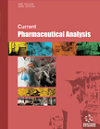- Home
- A-Z Publications
- Current Pharmaceutical Analysis
- Previous Issues
- Volume 2, Issue 1, 2006
Current Pharmaceutical Analysis - Volume 2, Issue 1, 2006
Volume 2, Issue 1, 2006
-
-
Applications of Stripping Voltammetry at Carbon Paste and Chemically Modified Carbon Paste Electrodes to Pharmaceutical Analysis
More LessIn this review, the analytical applications of carbon paste electrodes for pharmaceutical analysis are summarized, and future prospects examined, especially in connection with chemically and biologically modified carbon paste electrodes.
-
-
-
Review: Sample Concentration Based on Inclusion of Organic Solvents in Capillary Zone Electrophoresis
More LessBy Zak ShihabiCapillary electrophoresis, as an analytical tool for drugs, offers several advantages for pharmaceuticals and clinical applications; however, it suffers from poor detection limits. Concentration on the capillary (stacking) improves greatly this problem and is very easy to perform. One of the simple and practical methods to perform stacking is dissolving the sample in organic solvents and injecting a large volume of sample on the ca Read More
-
-
-
Method Development and Validation for the Direct Determination of Cefepime in Human Serum by Micellar Electrokinetic Capillary Chromatography
More LessAuthors: Toshihiro Kitahashi and Itaru FurutaA method for determining the concentration of cefepime, a cephem anti-microbial agent, by direct serum injection using micellar electrokinetic capillary chromatography is developed and its validation of the assay is studied. A borate buffer (100 mM; pH 8.0) containing sodium dodecyl sulfate (80 mM) is used as a run buffer. Ultraviolet detection is carried out at 260 nm. The migration time of cefepime is about 5.2 min. Read More
-
-
-
Alkyl Chloroformates in Sample Derivatization Strategies for GC Analysis. Review on a Decade Use of the Reagents as Esterifying Agents
More LessAuthors: Petr Husek and Petr SimekThe neccessity to derivatize polar analytes prior to separation often disqualifies gas chromatography (GC) as a method of choice in the field of biomedical/pharmaceutical analysis. Laborious and lengthy protocols for treating compounds prior to the analysis were discouraging. Only few derivatization approaches were well-established over decades, primarily silylations. To its assets belongs universality and efficacy, to sho Read More
-
-
-
Biochemical Micro-Techniques in the Diagnosis and Classification of Amyloidosis
More LessAuthors: Batia Kaplan, Brian M. Martin, Avi Livneh, Mordechai Pras and Gloria GalloAmyloidosis refers to a heterogeneous group of disorders characterized by the extracellular deposition of amyloid proteins in various tissues of the body. About 25 different amyloid proteins originating from presumably normal precursor proteins have been described so far. Identification of the chemical nature of amyloid is necessary in clinical practice, since both prognosis and treatment regimens are different in the various a Read More
-
-
-
Analytical Methodologies for Chloramphenicol Residues Determination in Food Matrixes: A Brief Review
More LessAuthors: Lucia Santos and Fernando RamosChloramphenicol (CAP) is a broad-spectrum antibiotic, effective against a wide range of microorganisms, and has widely been used since the 1950's to treat food-producing animals. However, CAP has been rapidly associated to serious toxic effects, especially bone marrow depression, particularly severe when it assumes the form of the doseindependent and fatal aplastic anaemia. The well-known risk of irreversible bone marrow d Read More
-
-
-
Main Active Components of St. John's Wort (Hypericum Perforatum) Extracts: Current Analytical Procedures for Pharmacokinetics and Concentration-Response Studies
More LessThe complete spectrum of active compounds of Hypericum perforatum (St. John's wort) has not yet been fully elucidated, but some naphthodianthrones (hypericin and pseudohypericin), phloroglucinols (hyperforin) and flavonoids (primarily quercetin glycosides) are thought to be essential for the antidepressant activity of its extracts. Some of these compounds modulate the expression of the P-glycoprotein transp Read More
-
-
-
F2-Isoprostanes: Review of Analytical Methods
More LessAuthors: Olivier Berdeaux, Olivier Scruel, Jean L. Cracowski and Thierry DurandF2-isoprostanes (F2-isoPs) represent a new family of biomarkers for oxidative stress generated by free radical attack of membrane-bounded arachidonic acid. Esterified F2-isoPs can be found in tissue or plasma lipids whereas the free form F2-isoPs, hydrolyzed by phospholipase, is mainly present in body fluids. The extent of systematic damage due to oxidative stress within the body can be assessed by the determination of Read More
-
-
-
The Impact of Self-Assembly in Medicine and Pharmacology
More LessAuthors: Mahnaz Derakhshan, Hamid R. Ansarian, Makoto Takafuji, Toshihiko Sakurai and Hirotaka IharaThe concept, molecular self-assembly, especially considering molecule-molecule interaction as an informationprocessing phenomenon, have a profoundly novel effect on thoughts and efforts related to Medicine and Pharmacology. This new style of thinking is still too novice to be used solely and independently for explanation of disease mechanisms and appropriate treatment strategies. However it calls for a range of new res Read More
-
-
-
Establishment of Conditionally Immortalized Cell Lines with Specific Functions and its Application to Differential Gene Expression Analysis by DNA Microarray Technology
More LessAuthors: Yoshiaki Tabuchi, Takashi Kondo and Masuo ObinataImmortalized cell lines that retain differentiated functions are required to study tissue functions at cellular and molecular levels. Transgenic animals, mice and rats, harboring temperature-sensitive simian virus 40 large T-antigen have been found to be very useful for establishing conditionally immortalized cell lines from tissues that have proved difficult to culture in vitro. Thus far we have succeeded in establishing many kinds Read More
-
Volumes & issues
-
Volume 20 (2024)
-
Volume 19 (2023)
-
Volume 18 (2022)
-
Volume 17 (2021)
-
Volume 16 (2020)
-
Volume 15 (2019)
-
Volume 14 (2018)
-
Volume 13 (2017)
-
Volume 12 (2016)
-
Volume 11 (2015)
-
Volume 10 (2014)
-
Volume 9 (2013)
-
Volume 8 (2012)
-
Volume 7 (2011)
-
Volume 6 (2010)
-
Volume 5 (2009)
-
Volume 4 (2008)
-
Volume 3 (2007)
-
Volume 2 (2006)
-
Volume 1 (2005)
Most Read This Month
Article
content/journals/cpa
Journal
10
5
false
en


